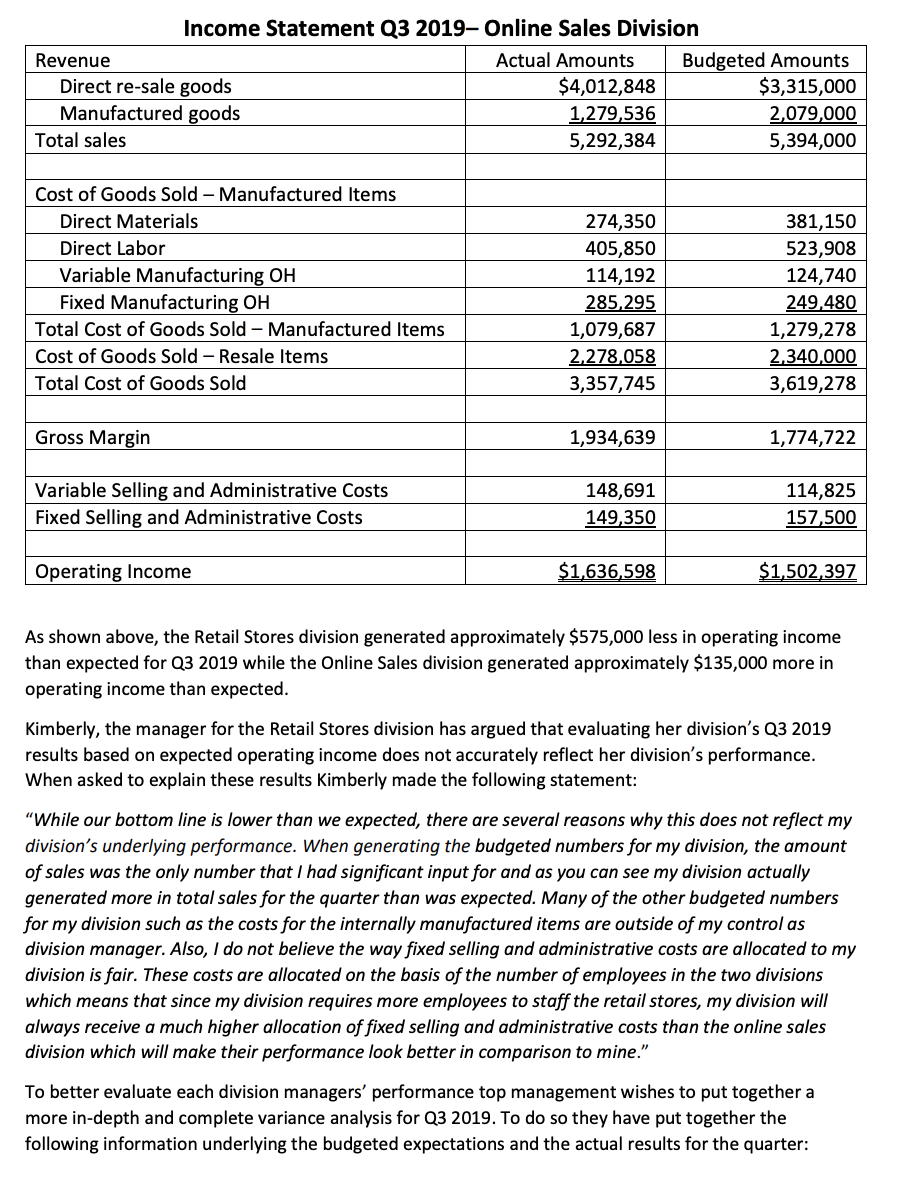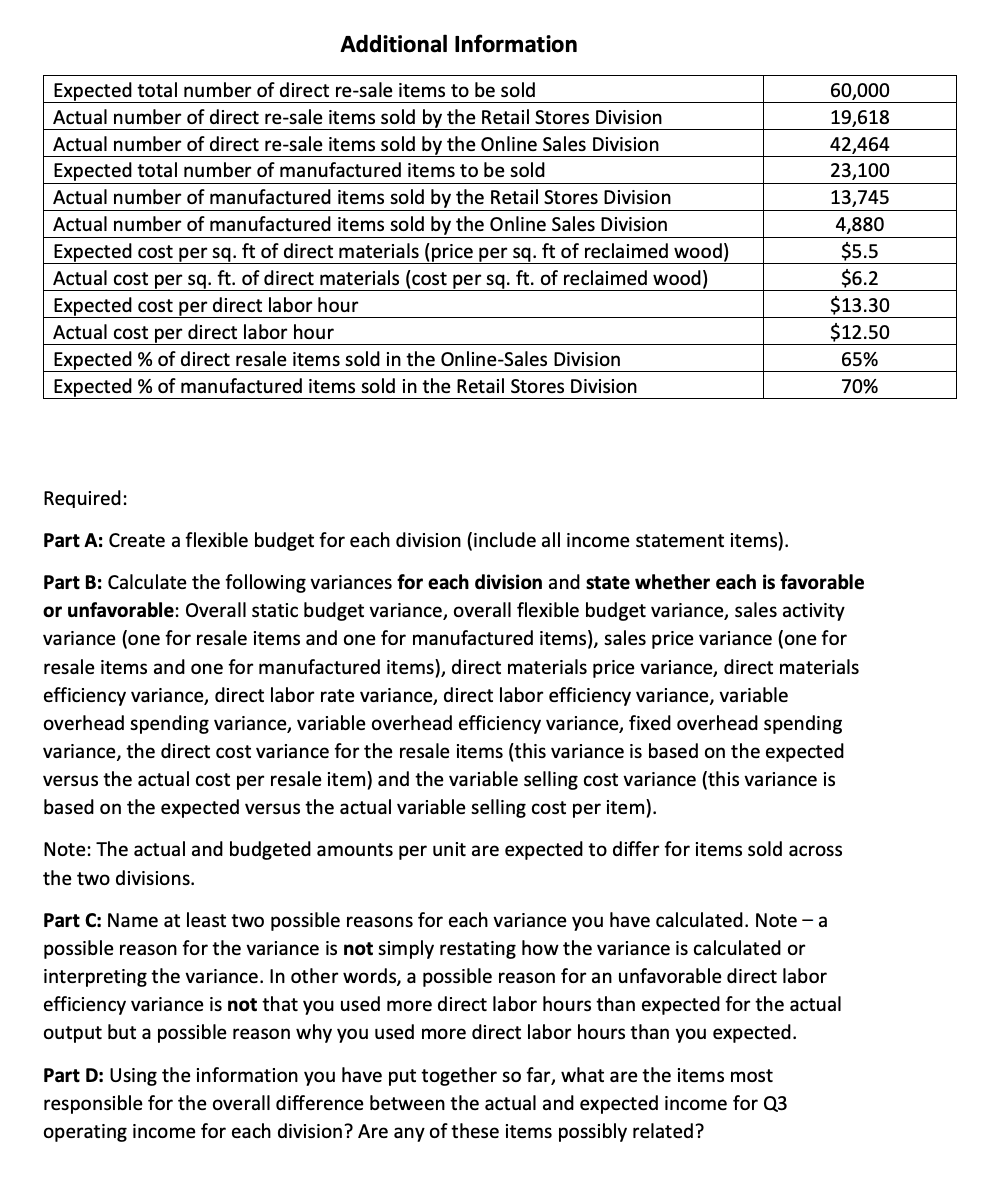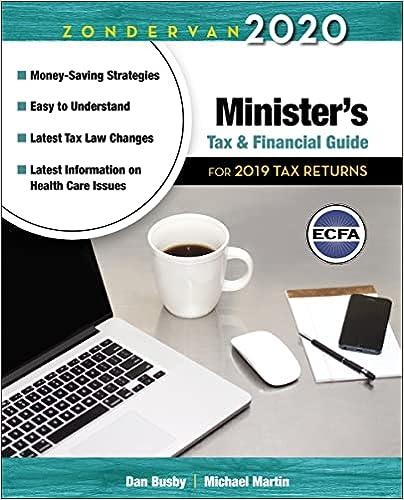


Income Statement Q3 2019, Retail Stores Division Revenue Actual Amounts Budgeted Amounts Direct re-sale goods $2,128,553 $2,100,000 Manufactured goods 6,677,321 6,468,000 Total sales 8,805,874 8,568,000 Cost of Goods Sold - Manufactured Items Direct Materials Direct Labor Variable Manufacturing OH Fixed Manufacturing OH Total Cost of Goods Sold - Manufactured Items Cost of Goods Sold - Resale Items Total Cost of Goods Sold 1,460,100 1,580,675 321,633 571,447 3,933,855 1,353,642 5,287,497 986,370 1,290,366 388,080 582,120 3,246,936 1,417,500 4,664,436 Gross Margin 3,518,377 3,903,564 Variable Selling and Administrative Costs Fixed Selling and Administrative Costs 567,171 538,901 371,700 542,500 Operating Income $2,412,305 $2.989,364 Income Statement Q3 2019-Online Sales Division Revenue Actual Amounts Budgeted Amounts Direct re-sale goods $4,012,848 $3,315,000 Manufactured goods 1,279,536 2,079,000 Total sales 5,292,384 5,394,000 Cost of Goods Sold - Manufactured Items Direct Materials Direct Labor Variable Manufacturing OH Fixed Manufacturing OH Total Cost of Goods Sold - Manufactured Items Cost of Goods Sold - Resale Items Total Cost of Goods Sold 274,350 405,850 114,192 285,295 1,079,687 2.278,058 3,357,745 381,150 523,908 124,740 249.480 1,279,278 2.340,000 3,619,278 Gross Margin 1,934,639 1,774,722 Variable Selling and Administrative Costs Fixed Selling and Administrative Costs 148,691 149,350 114,825 157,500 Operating Income $1,636,598 $1,502,397 As shown above, the Retail Stores division generated approximately $575,000 less in operating income than expected for Q3 2019 while the Online Sales division generated approximately $135,000 more in operating income than expected. Kimberly, the manager for the Retail Stores division has argued that evaluating her division's Q3 2019 results based on expected operating income does not accurately reflect her division's performance. When asked to explain these results Kimberly made the following statement: "While our bottom line is lower than we expected, there are several reasons why this does not reflect my division's underlying performance. When generating the budgeted numbers for my division, the amount of sales was the only number that I had significant input for and as you can see my division actually generated more in total sales for the quarter than was expected. Many of the other budgeted numbers for my division such as the costs for the internally manufactured items are outside of my control as division manager. Also, I do not believe the way fixed selling and administrative costs are allocated to my division is fair. These costs are allocated on the basis of the number of employees in the two divisions which means that since my division requires more employees to staff the retail stores, my division will always receive a much higher allocation of fixed selling and administrative costs than the online sales division which will make their performance look better in comparison to mine." To better evaluate each division managers' performance top management wishes to put together a more in-depth and complete variance analysis for Q3 2019. To do so they have put together the following information underlying the budgeted expectations and the actual results for the quarter: Additional Information Expected total number of direct re-sale items to be sold Actual number of direct re-sale items sold by the Retail Stores Division Actual number of direct re-sale items sold by the Online Sales Division Expected total number of manufactured items to be sold Actual number of manufactured items sold by the Retail Stores Division Actual number of manufactured items sold by the Online Sales Division Expected cost per sq. ft of direct materials (price per sq. ft of reclaimed wood) Actual cost per sq. ft. of direct materials (cost per sq. ft. of reclaimed wood) Expected cost per direct labor hour Actual cost per direct labor hour Expected % of direct resale items sold in the Online-Sales Division Expected % of manufactured items sold in the Retail Stores Division 60,000 19,618 42,464 23,100 13,745 4,880 $5.5 $6.2 $13.30 $12.50 65% 70% Required: Part A: Create a flexible budget for each division (include all income statement items). Part B: Calculate the following variances for each division and state whether each is favorable or unfavorable: Overall static budget variance, overall flexible budget variance, sales activity variance (one for resale items and one for manufactured items), sales price variance (one for resale items and one for manufactured items), direct materials price variance, direct materials efficiency variance, direct labor rate variance, direct labor efficiency variance, variable overhead spending variance, variable overhead efficiency variance, fixed overhead spending variance, the direct cost variance for the resale items (this variance is based on the expected versus the actual cost per resale item) and the variable selling cost variance (this variance is based on the expected versus the actual variable selling cost per item). Note: The actual and budgeted amounts per unit are expected to differ for items sold across the two divisions. Part C: Name at least two possible reasons for each variance you have calculated. Note-a possible reason for the variance is not simply restating how the variance is calculated or interpreting the variance. In other words, a possible reason for an unfavorable direct labor efficiency variance is not that you used more direct labor hours than expected for the actual output but a possible reason why you used more direct labor hours than you expected. Part D: Using the information you have put together so far, what are the items most responsible for the overall difference between the actual and expected income for Q3 operating income for each division? Are any of these items possibly related? Income Statement Q3 2019, Retail Stores Division Revenue Actual Amounts Budgeted Amounts Direct re-sale goods $2,128,553 $2,100,000 Manufactured goods 6,677,321 6,468,000 Total sales 8,805,874 8,568,000 Cost of Goods Sold - Manufactured Items Direct Materials Direct Labor Variable Manufacturing OH Fixed Manufacturing OH Total Cost of Goods Sold - Manufactured Items Cost of Goods Sold - Resale Items Total Cost of Goods Sold 1,460,100 1,580,675 321,633 571,447 3,933,855 1,353,642 5,287,497 986,370 1,290,366 388,080 582,120 3,246,936 1,417,500 4,664,436 Gross Margin 3,518,377 3,903,564 Variable Selling and Administrative Costs Fixed Selling and Administrative Costs 567,171 538,901 371,700 542,500 Operating Income $2,412,305 $2.989,364 Income Statement Q3 2019-Online Sales Division Revenue Actual Amounts Budgeted Amounts Direct re-sale goods $4,012,848 $3,315,000 Manufactured goods 1,279,536 2,079,000 Total sales 5,292,384 5,394,000 Cost of Goods Sold - Manufactured Items Direct Materials Direct Labor Variable Manufacturing OH Fixed Manufacturing OH Total Cost of Goods Sold - Manufactured Items Cost of Goods Sold - Resale Items Total Cost of Goods Sold 274,350 405,850 114,192 285,295 1,079,687 2.278,058 3,357,745 381,150 523,908 124,740 249.480 1,279,278 2.340,000 3,619,278 Gross Margin 1,934,639 1,774,722 Variable Selling and Administrative Costs Fixed Selling and Administrative Costs 148,691 149,350 114,825 157,500 Operating Income $1,636,598 $1,502,397 As shown above, the Retail Stores division generated approximately $575,000 less in operating income than expected for Q3 2019 while the Online Sales division generated approximately $135,000 more in operating income than expected. Kimberly, the manager for the Retail Stores division has argued that evaluating her division's Q3 2019 results based on expected operating income does not accurately reflect her division's performance. When asked to explain these results Kimberly made the following statement: "While our bottom line is lower than we expected, there are several reasons why this does not reflect my division's underlying performance. When generating the budgeted numbers for my division, the amount of sales was the only number that I had significant input for and as you can see my division actually generated more in total sales for the quarter than was expected. Many of the other budgeted numbers for my division such as the costs for the internally manufactured items are outside of my control as division manager. Also, I do not believe the way fixed selling and administrative costs are allocated to my division is fair. These costs are allocated on the basis of the number of employees in the two divisions which means that since my division requires more employees to staff the retail stores, my division will always receive a much higher allocation of fixed selling and administrative costs than the online sales division which will make their performance look better in comparison to mine." To better evaluate each division managers' performance top management wishes to put together a more in-depth and complete variance analysis for Q3 2019. To do so they have put together the following information underlying the budgeted expectations and the actual results for the quarter: Additional Information Expected total number of direct re-sale items to be sold Actual number of direct re-sale items sold by the Retail Stores Division Actual number of direct re-sale items sold by the Online Sales Division Expected total number of manufactured items to be sold Actual number of manufactured items sold by the Retail Stores Division Actual number of manufactured items sold by the Online Sales Division Expected cost per sq. ft of direct materials (price per sq. ft of reclaimed wood) Actual cost per sq. ft. of direct materials (cost per sq. ft. of reclaimed wood) Expected cost per direct labor hour Actual cost per direct labor hour Expected % of direct resale items sold in the Online-Sales Division Expected % of manufactured items sold in the Retail Stores Division 60,000 19,618 42,464 23,100 13,745 4,880 $5.5 $6.2 $13.30 $12.50 65% 70% Required: Part A: Create a flexible budget for each division (include all income statement items). Part B: Calculate the following variances for each division and state whether each is favorable or unfavorable: Overall static budget variance, overall flexible budget variance, sales activity variance (one for resale items and one for manufactured items), sales price variance (one for resale items and one for manufactured items), direct materials price variance, direct materials efficiency variance, direct labor rate variance, direct labor efficiency variance, variable overhead spending variance, variable overhead efficiency variance, fixed overhead spending variance, the direct cost variance for the resale items (this variance is based on the expected versus the actual cost per resale item) and the variable selling cost variance (this variance is based on the expected versus the actual variable selling cost per item). Note: The actual and budgeted amounts per unit are expected to differ for items sold across the two divisions. Part C: Name at least two possible reasons for each variance you have calculated. Note-a possible reason for the variance is not simply restating how the variance is calculated or interpreting the variance. In other words, a possible reason for an unfavorable direct labor efficiency variance is not that you used more direct labor hours than expected for the actual output but a possible reason why you used more direct labor hours than you expected. Part D: Using the information you have put together so far, what are the items most responsible for the overall difference between the actual and expected income for Q3 operating income for each division? Are any of these items possibly related









